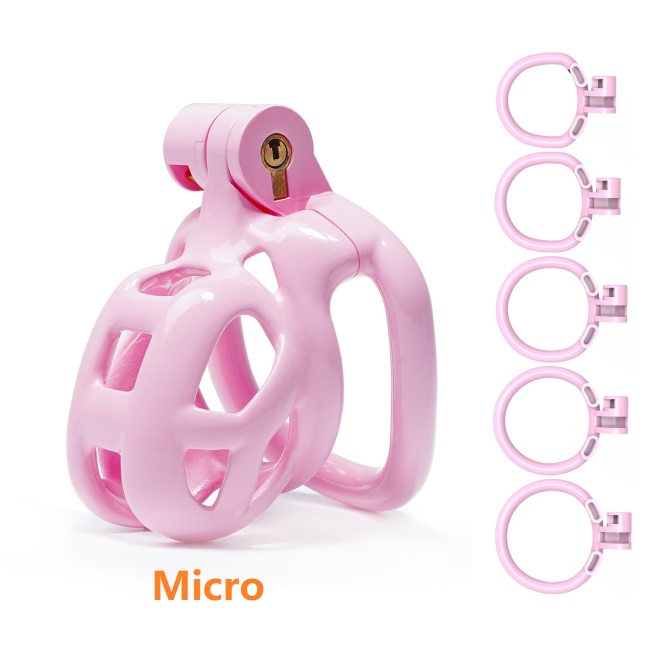Materials Matter: Choosing Safe Materials for Long Term Chastity Devices
2025-10-20
When it comes to long-term chastity, the most important decision isn't the lock—it's the material.
Your device will stay in constant contact with delicate skin, so that the wrong material can cause irritation, odor, or even infection. The right one, however, offers comfort, security, and peace of mind.
This guide explores the safest materials for all types of chastity devices, including catheter chastity, catheter cages, and comfortable chastity belts for guys, helping every user find the perfect match between safety and pleasure.
1. Why Material Choice Defines Long Term Safety
Wearing a chastity device for days or weeks requires balance: it must be durable, breathable, and skin-safe. Body heat, sweat, and movement increase sensitivity—so low-quality materials can quickly lead to rashes or allergic reactions.
Safe material selection is essential for:
- Preventing infections from moisture buildup
- Avoiding allergic reactions (e.g., nickel or latex sensitivity)
- Maintaining long-term comfort for daily wear
- Ensuring hygiene in catheter-compatible designs
2. Common Materials in Chastity Devices
2.1 Plastic and Polycarbonate
- Lightweight and beginner-friendly
- Affordable but not highly breathable
- Works well for short-term or discreet use
2.2 Medical-Grade Resin and Acrylic
- Transparent, smooth, and low-allergy risk
- Often used in discreet chastity cages
- Medical resin resists aging and deformation
- Avoid cheap resins containing BPA

2.3 TPE and Silicone
- Soft, flexible, and excellent for sensitive skin
- Water-based lubricants recommended
- Slight discoloration or stickiness means it's time to replace
- Perfect for comfortable chastity belts and inner linings
2.4 Natural Rubber and Latex
- Extremely elastic and snug-fitting
- Not suitable for long-term wear due to allergy risk
- Even "low-allergy" latex degrades faster with heat and sweat
2.5 Metal: Stainless Steel, Titanium, Aluminum
316L Medical-Grade Stainless Steel
- The gold standard for guys' chastity belts
- Corrosion-resistant, non-reactive, easy to sterilize
- Perfect for long-term chastity due to strength and safety
Titanium
- Lightweight, ultra-strong, and fully biocompatible
- Ideal for sensitive skin users
- Maintains comfort even under tight fit designs
Aluminum
- Very light but can bend over time
- Some alloys may contain nickel—avoid if sensitive
- Better suited for short-term or light use
2.6 3D-Printed Materials (PLA, PETG, Nylon)
- Customizable with precise fits and air vents
- Excellent for ventilated long term chastity cages
- Needs surface coating to prevent sweat absorption
- Avoid boiling; high heat deforms most filaments

2.7 Guys Chastity Belt: Special Material Requirements
Male physiology requires both support and airflow.
- Best combo: 316L stainless steel frame + TPE inner lining
- Silicone padding reduces friction during movement
- Mesh or perforated designs improve breathability
- For athletic users, lightweight titanium belts are ideal
3. How to Choose a Comfortable Chastity Belt
A comfortable chastity belt isn't just soft—it's engineered for body harmony.
Here are the three key factors affecting comfort:
- Elasticity and Fit – The material should move with the body, not against it.
- Silicone or TPE liners absorb pressure and reduce chafing.
- Ventilation Design – Perforated metal or 3D vents prevent moisture buildup.
- Adjustability – Look for adjustable straps and flexible waist connections for long-term wear.
Pro tip: For long-term comfort, alternate between metal and silicone belts every few weeks to let the skin recover.
4. Catheter Chastity & Catheter Cage: Safety and Materials
Catheter chastity devices and catheter cages combine chastity control with urination management. Because the catheter enters the urethra, material safety becomes even more critical.
Recommended Materials
- Medical-grade silicone: Soft, non-reactive, and flexible, ideal for catheters and insertion tubes.
- Titanium: Excellent for long-term catheter tips due to high biocompatibility.
- Avoid PVC or cheap rubber, which may cause urethral irritation or infection.
Usage and Hygiene Tips
- Always sterilize catheter components before and after use.
- Ensure the catheter tube fits snugly but without friction.
- Rinse with saline or sterile water after removal.
- Never share catheter devices—cross-contamination risk is high.
Best for
Users practicing long-term chastity who want continuous wear without frequent removal, but still value hygiene and safety.
5. Material Comparison Table
| Material | Comfort | Hygiene | Durability | Ventilation | Best For |
|---|---|---|---|---|---|
| Plastic/Polycarbonate | Medium | Fair | Medium | Low | Beginners |
| Medical Resin/Acrylic | High | Good | High | Medium | Discreet cages |
| TPE/Silicone | Very High | Good | Medium | Medium | Comfortable belts |
| Latex/Rubber | High | Fair | Low | High | Short sessions |
| 316L Stainless Steel | Medium | Excellent | High | Low | Guys chastity belts |
| Titanium | Very High | Excellent | Very High | Low | Long term chastity |
| Aluminum | Medium | Good | Medium | Medium | Lightweight wear |
| 3D-Printed + TPE | Very High | Good | Medium-High | Very High | Breathable designs |
6. Skin Compatibility and Testing
Before using any chastity belt or catheter chastity, always perform a patch test:
- Place the material on your inner wrist or groin area for 24–48 hours.
- Redness, itching, or burning = allergy.
- Mild warmth or no change = safe.
Immediate vs. Delayed Allergies
- Immediate: Nickel, latex—reaction within hours.
- Delayed: Low-grade silicone—reaction after 1–2 weeks.
- Monitor for gradual discomfort; it may signal material fatigue or irritation.
7. Maintenance and Cleaning Tips
Metal Devices
- Wash with antibacterial soap and warm water.
- Avoid acidic cleaners to protect the surface.
TPE / Silicone
- Rinse with warm water and air dry.
- Use water-based lubricants only.
- Replace when tacky or powdery.
3D-Printed Devices
- Clean with mild soap; avoid heat over 60°C.
- Check seams for cracks monthly.
Catheter Chastity
- Use sterile saline for cleaning.
- Dry completely before reassembly.
- Store separately in a clean, dust-free bag.
8. Expert Advice for Different Users
For Beginners
- Start with medical-grade TPE or silicone belts.
- Avoid complex catheter models until experienced.
For Sensitive Skin Users
- Choose titanium or 316L stainless steel.
- Avoid painted metals or mixed alloys.
For Long Term Chastity Users
- Prioritize breathable 3D designs with silicone liners.
- Rotate materials every few months.
For Male Wearers
- Select designs tailored to anatomy:
- Wider base rings
- Soft silicone inner layers
- Proper urethral alignment for hygiene

9. If Irritation Occurs
- Remove the device immediately.
- Clean the area with warm water and gentle soap.
- Apply antibacterial ointment.
- If symptoms persist, consult a doctor before reuse.
10. Final Thoughts: Safety, Comfort, and Confidence
In long term chastity, safety and comfort are inseparable.
At rupipichastity, we select materials that meet medical-grade standards and maintain excellent breathability.
Whether you wear a guys chastity belt, a catheter cage, or a comfortable silicone device, your comfort depends on one thing—respecting your body's needs.
Invest once, clean regularly, and wear confidently.









